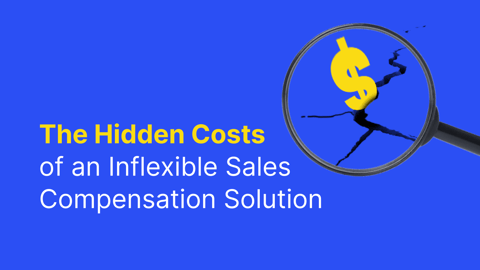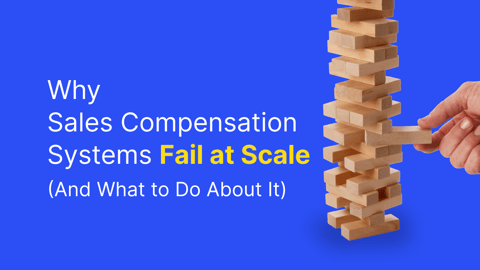Sales reps have complex and multi-layered motivations. When designing a sales compensation program that taps into these motivations to encourage positive behavior, it's impossible to take a one-size-fits-all approach. Instead, it's important to take some time upfront to define precisely what you want your sales incentive program to achieve and how you can achieve much better results.
- What's a Sales Incentive Structure?
- How Does a Sales Incentive Structure Work?
- 6 Steps to Creating Effective Incentive Pay Plans
What's a Sales Incentive Structure?
A sales incentive structure is the framework a business uses to assess, design, and manage their core sales incentive model for their sales team. Sales compensation is critical in managing and directing a high-performance sales team. It can cover a range of variables, including commission plans, quota levels, bonus plans, sales kickers and accelerators, quota club destinations, and anything else that a company's sales managers believe will focus and motivate their sales reps.
How Does a Sales Incentive Structure Work?
An effective sales incentive structure aims to provide visibility for a sales rep about what’s expected of them by their management, as well as provide motivation to hit their targets. At the beginning of each sales year, sales reps will receive their sales targets and commission plan, so they should know what they can potentially earn if they close enough business. With a focus on motivating reps, a well-designed sales incentive program will help maximize sales productivity by providing clear direction for sales team members as to what good sales behavior looks like.
Sales reps should feel that the sales compensation plan they’re presented with is realistic, achievable, and promotes success across the whole sales organization. The right sales incentive program needs to balance science and art to help the business achieve its revenue targets.
6 Steps to Creating Effective Incentive Pay Plans
1. Eligibility
The first question you should ask when creating a sales compensation framework is: who should you include in the scheme? For some groups, it's immediately obvious whether they should or shouldn't be included. For example, in the case of a sales incentive plan, for core frontline sales staff that own customer territories and relationships, the answer is nearly always "yes". Equally, those that work in entirely non-customer-facing support roles—including clerical and back-office roles—should clearly not be eligible for a sales incentive plan (though they probably should be eligible for a broader corporate incentive plan).
For those employees whose job functions fall between these two camps, where do you draw the line? As sales processes become increasingly complex and involve numerous participants, navigating this grey area can become a complicating factor in building an effective sales compensation program.
For example, there's often a wide range of technical resources involved during the sales process—some contributing prominently to the sale, others participating purely in a more technical capacity. Paying incentives simply because someone happens to sit in a particular organizational hierarchy, rather than based on their actual contribution to a specific sale, is a trap that many companies fall into.
Although it's far from an exact science, it's vital to define clear eligibility criteria and communicate these criteria effectively to your workforce. Without clear, unambiguous communication, you run the risk of causing confusion and dissatisfaction among employees, which can ultimately undermine the success of your entire incentive program.
2. Performance Measures
Once you've decided who's eligible, the next step is to choose which outcomes will trigger an incentive payment by defining the performance measures on which your plan is based.
Performance measures are the strategic engine of your incentive compensation plan, enabling you to achieve alignment with business priorities and have a real impact on employee behavior. By far the most common sales incentive performance metric is revenue. But paying for revenue alone doesn't mean that most sales incentive plans fail to reward for profitable sales. The reality is that a true 'profit' metric is often hard to measure and track at the individual salesperson level. Instead, what's more often used are proxies for profitability.
This can be achieved by weighting revenue for certain product categories more heavily than others (essentially, rewarding for product mix), or by measuring things such as price realization (for example, the percent of list price attained—which is another driver of profitability that is often directly impacted by the sales force).
Taking time to define performance measures can pay off for other parts of the organization too. For example, although roles that support the sales process may not be eligible for the sales incentive plan, their individual performance objectives can and should correspond with metrics assigned to the sales teams to ensure that they both work towards the same goals. As a result, these supporting personnel can also be aligned with the strategic aims of the sales force, without being placed on a sales incentive scheme that doesn't otherwise align with their role.
‘Set it and forget it’ isn’t the most effective strategy when it comes to performance measures. As the market fluctuates and the organizational priorities change, you should evaluate your incentives plans to see if they’re leading to the right outcomes. Take this quiz to quickly assess where your incentive plans stand.
3. Pay Mix
Next, turn your attention to the pay mix—the ratio between base salary and incentive pays at target performance. For this, your decisions should relate closely to what types of sales roles you have, taking into account factors such as the length and complexity of your typical sales cycle, as well as the impact of the sales role on buying decisions.
For example, companies with sales roles focused on acquiring new business with short sales cycles can encourage this 'hunting behavior' by using a greater proportion of variable compensation. On the other hand, industries that center on longer, more complex sales cycles, which are often highly relationship-dependent, are often better off using a mix of pay that is more heavily weighted to fixed pay.
Either way, it's critical in both cases that the variable payments still represent a meaningful proportion of total compensation, or you run the risk of your incentive plan having no significant impact on behavior.
Many companies spend too much time worrying that they don't have 'enough' pay at risk for sales jobs. While pay mix is an important element to get right, it's also the hardest one to change in the short-term—and more variable pay isn't always the right answer. Therefore, it's important to take a long-term view when setting the target pay mix and not let it hold the rest of the plan hostage. There are plenty of changes you can make in other areas to improve your plan's effectiveness—even if you feel like your pay mix is out of alignment and you can't change it in the short term.
4. Total Target Cash Value
To ensure that you attract and retain the right talent, benchmarking the target total cash earnings opportunity against competitors' offerings provides a simple way to evaluate the competitiveness of your pay package. Because of the variation in pay mix for different sales jobs in the market, it's critical to look at the competitiveness of total cash compensation, rather than considering base salary or incentive compensation in isolation. Looking only at the competitiveness of fixed salaries may give you misleading results if your mix of pay is more or less variable than the market average.
It's also important not to simply default to looking only at median total cash data when considering the competitiveness of your pay. The key here is to ensure you're not over-paying under-performers and under-paying the very best performers. Therefore, it's important to also understand the degree of variability in pay in the market, rather than considering whether a single point (such as the market median) aligns with your overall pay philosophy.
Remember: for jobs outside the sales function, there tends to be much less variation in the mix of pay—and the level of variation is typically tied very closely to hierarchical levels rather than role distinctions within a particular level. For this reason, focusing primarily on the competitiveness of base salaries often works fine for functions outside sales, but within sales, this approach can be misleading.
5. Payout Mechanics
Once you've decided who, what and how much to pay within your sales compensation plan framework, you're ready to address the payout mechanics of the plan. Here, you need to decide on the formulae to calculate earnings, the shape of the payout curves, and the rate of acceleration. This may also include a threshold (a minimum performance level that must be attained before earning any incentive), and caps or other mechanisms that provide financial risk protection.
Frequently, companies fail to clearly articulate both dimensions of payout mechanics (both performance and payout) causing confusion. For example, companies will refer to a 70% threshold within their framework, without clearly defining whether that refers to the performance requirement or the payout earned. Without a solid grip on payout mechanics, sales compensation plans can easily mystify plan participants and administrators alike.
Unlike other elements of plan design (like pay levels), payout mechanics should be driven less by competitive market practice and more by internal considerations related to the type of metric used and the expected variability in performance.
As a best practice, thresholds should be set at a level that's met by the majority—around 90%—of the sales force. Why? Because if many more than this are below the threshold, they're not "in the game". And if they’re not participating in the plan, even at very low earnings levels, they have no motivation to make incremental performance improvements.
For companies operating in unpredictable markets—such as emerging markets or those selling new products—it's important that incentive frameworks reflect the variability of that environment. This may mean using lower thresholds and more modest rates of acceleration. In contrast, those in very predictable (and typically more mature markets) may need more aggressive curves with greater acceleration in earnings and higher thresholds. Otherwise, they risk having insufficient differentiation in earnings between lower and higher performers.
Take a deeper dive into incentive pay and how it can help your business managers achieve their objectives with our latest article, 4 Ways to Make Your Incentive Pay Plans Boost Your Business.
6. Payout Frequency
The final step in building an effective incentive compensation plan is payout frequency: how often you pay incentive earnings.
As a general rule, it's best to pay as close to the time of the sale as possible to help maximize the motivational impact. In particular, for environments where most sales are of the short transactional type, monthly or quarterly payments are usually recommended. However, where employees are managing customer accounts over long periods of time with gradual incremental sales, it can be impractical to measure and pay for sales on such a frequent basis. In these cases, an annual plan is likely a better fit.
To make life more complicated, some plans may operate on an annual basis but are calculated and paid quarterly (i.e., quarterly year-to-date plans), increasing complexity from an administrative point of view.
What's more, it's quite common that within the same organization it may be appropriate to pay some incentive elements more frequently than others. This is one area where one rule doesn't fit all, and the final decision should be based less on typical market practices, and instead, more on your own sales roles and business requirements.
With all six steps carefully put together to meet the needs of your company, you'll have solid foundations for optimal sales performance. But your work shouldn't end there: the key to continued success for an incentive compensation plan framework is ongoing communication about the scheme with your employees, implementation, and management. After all, you can get all the elements just right, but without a long-term approach, it can crumble before your eyes—as it has for many companies.
To protect against the failure of your sales compensation framework, the final step is to put a process in place that creates understanding for employees and administrators and, ultimately, generates their buy-in. If you take the time to do so, the results will speak for themselves.
Once your sales compensation plan is set in motion, how do you calculate sales compensation success? Measure your sales compensation performance with key factors that can have a significant impact on how fast your revenue grows. Download our free guide, Change the Way You Measure Sales Compensation Success to learn more.



